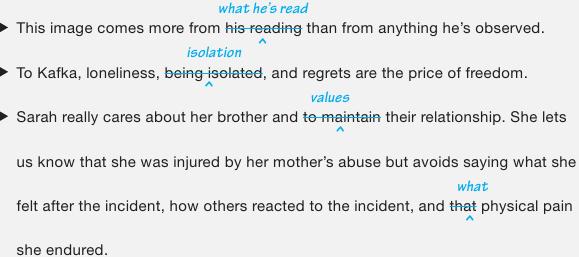Edit and proofread your draft.
For more on document design, see Chapter 21. For guidelines on formatting a writing project and acknowledging the sources of visuals in MLA style, see Chapter 27.
Our research has identified several errors that occur often in essays that analyze short stories, including problems with parallelism and the use of ellipsis marks. The following guidelines will help you check your essay for these common errors.
Using Parallel Structure
The Problem When you present items as a pair or in a series (for example, I gave him x and y; or I gave him x, y, and z), you must present the items in the series in the same grammatical form—all nouns, all prepositional phrases, all adverb clauses, and so on. Mixing and matching leads to lack of clarity and lessens the impact of your prose. Take as an example one of Iris Lee’s first-draft sentences:
The doctor’s actions actually hurt rather than providing any benefit to a patient.
A Note on Grammar and Spelling Checkers
These tools can be helpful, but do not rely on them exclusively to catch errors in your text: Spelling checkers cannot catch misspellings that are themselves words, such as to for too. Grammar checkers miss some problems, sometimes give faulty advice for fixing problems, and can flag correct items as wrong. Use these tools as a second line of defense after your own (and, ideally, another reader’s) proofreading and editing efforts.
“Hurt” is a one-word verb; “providing any benefit to,” which should be a parallel item, combines an -ing verb, an adjective, an object, and a preposition. The resulting sentence is unnecessarily complicated and clumsy.
The Correction Lee eventually edited the sentence as follows:

The parallelism of hurt and help puts the verbs in the same form and emphasizes the contrast between these two actions in a way that the first-draft wording did not. For more examples, see the following sentences:

Using Ellipsis Marks Correctly
For more on using ellipsis marks to indicate a deletion from a quotation, see Chapter 26.
You will often quote sources when you analyze a story, and you must be careful to use ellipsis marks (or ellipses)—three spaced periods—to indicate places where you delete material from a quotation. Look, for example, at how Iris Lee, in an early draft of her essay, used ellipsis marks in quoting from “The Use of Force.”
| Passage from Story | Quotation with Ellipsis Marks |
| When finally I got the wooden spatula behind the last teeth and just the point of it into the mouth cavity, she opened up for an instant but before I could see anything she came down again and gripping the wooden blade between her molars she reduced it to splinters before I could get it out again. . . . (Williams, par. 29) | In describing his attempts to get the wooden spatula into the girl’s mouth, the narrator says “she opened up for an instant but . . . came down again and gripping the wooden blade between her molars reduced it to splinters.” |
The Problem Failing to use ellipsis marks to indicate the omission of material misrepresents the quote, which is a serious breach of convention. Using ellipsis marks incorrectly makes your readers doubt your knowledge of conventions.
The Correction If you are using MLA style, follow these rules about using ellipsis marks:
- When you delete words from the middle of a quoted sentence, add ellipsis marks, and leave a single space before and after each ellipsis point.
- When you delete words from the end of a quoted sentence and a grammatically complete sentence remains, add a period after the last word and then three ellipsis marks.
- Leave a single space after the period and each of the first two ellipsis marks. Do not leave a space between the last mark and the closing quotation mark.
- When you delete material from the middle of a passage of two or more sentences, use ellipsis marks where the text is omitted and a period after the preceding text if it is a grammatically complete sentence.
- When you delete words from the beginning of a quoted sentence, use ellipsis marks only if the remainder of the sentence begins with a capitalized word and is a grammatically complete sentence.
- Single words and brief phrases can be quoted without ellipsis marks.
Examples of sentences edited to show correct usage follow:
